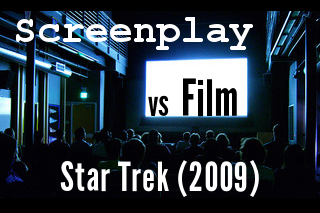Although I was never a Trekkie, I have a lot of affection for the Star Trek series, especially for Star Trek: The Next Generation. When I was a kid, TNG was the last good show before the news took over the networks. The Enterprise was mesmerizing. Captain Picard was the epitome of cool.
And Data? Data was a badass.
I’ve seen one or two Star Trek movies, but they were always a disappointment in comparison to TNG. When I planned to watch the Star Trek reboot, directed by JJ Abrams and written by Roberto Orci and Alex Kurtzman, I went in with modest expectations. I was pleasantly surprised.
Star Trek, the reboot, had it all: action, adventure, a hint of romance, a smattering of well-timed one-liners, and a clever time-travel twist. It had spectacle in spades, but even better, the movie had heart.
It was a true pleasure to watch Kirk and Spock build their friendship, and to see the original Star Trek team come into being. And young Spock meeting future Spock–what a mindbender! One of the best movie moments ever. For me, and probably for a lot of Trekkies, that alone was worth the price of admission.
I was lucky enough to find a shooting script draft from 2007 to use to compare with the movie released in theaters. Even at that late stage in the production process, there were still a number of differences between the script and the movie.
The most significant change had to do with the storyline for the villain, Nero, played by an unrecognizable Eric Bana. Scenes which made him a more sympathetic character were cut from the movie. This change could’ve been made for budget reasons, for scheduling reasons…or for something more ephemeral (more on that in the screenwriting tips from part two of this post).
There were a few minor changes as well. Studying them made me feel like I was getting an inside peek into JJ Abrams’s mind–and that’s an experience alright! By examining these small differences along with me, you should gain insight into how professional screenwriters make their storytelling decisions.
If the shooting script exactly mirrored the movie released in theaters, the movie still would have been a resounding success. But cutting out scenes tightened the story focus and greatly improved the overall movie experience. Longer isn’t necessarily better. Eliminating scenes isn’t just about saving money or pleasing exhibitors who want to cram in as many showings as possible. It’s also about making choices which clarify the storyline and using screentime to give weight to the prime players.
This is a really important aspect of screenwriting that most amateur screenwriters don’t easily grasp. If you tend to write overly long screenplays, then make sure to study the screenwriting tips I learned from Star Trek. They should help you learn how to cut the scenes which seem so essential to you now–and why you should.
Onto the screenwriting tips I learned by comparing Star Trek’s shooting script to the movie version released in theaters:
Screenwriting Tip #1: The beginning scenes of your screenplay should belong to the hero
The movie version of Star Trek opened with George Kirk becoming captain of the USS Kelvin, and defending his spacecraft against Nero’s Narada, a more powerful spacecraft with advanced weaponry…all while his wife gives birth to their son, Jim Kirk.
The shooting script I found also began with a birth–but Spock’s, not Kirk’s (although Kirk’s did follow shortly thereafter).
FADE IN:
EXT. VULCAN FAMILY HOME – DUSK
The image is spectacular, aglow in DUSK LIGHT: a beautiful BABY, just born, held in a WOMAN’S HANDS. It is being cleaned; warm water runs down its face and body.
TIGHT ON the MIDWIFE (female, 60’s) who holds and cleans the baby as it CRIES. Another, younger, Midwife can be seen behind her, assisting with the pitchers of water. As she cleans the baby, she says to someone OFF-CAMERA:
MIDWIFE
He is strong.
The baby, now calm, gets SWADDLED. He is then gently held out to the new MOTHER:
AMANDA GRAYSON, late 20’s. An original beauty. She lies on a divan, spent but eager to hold her first child. She tenderly takes the infant into her arms, tears in her eyes, mesmerized. She holds the wrapped baby tight and whispers sweetly:
AMANDA
…hello.
CLOSE ON the YOUNGER MIDWIFE, standing at the rear of the room. She raises an eyebrow as she quietly speaks:
YOUNGER MIDWIFE
The baby is healthy. Why does she cry?
MIDWIFE
(a beat; then)
She is human.
I’m glad the production team made the decision to eliminate showing Spock’s birth in the movie. For one thing, in comparison to Kirk’s birth, Spock’s is a snoozefest.
Secondly, it’s redundant to see two birth scenes, one right after the other. Typically, you should avoid repeating the same story beat in your screenplay (for an example of what not to do, refer to screenplay writing tip #3 in 6 Reasons Why Date Night Was a Dud)…unless the repetition is necessary to pull off a joke or underscore a point through comparison and contrast.
For example, if you were writing a “prince and pauper” story, you might show how different the same life event is for your two main characters. (Although I still contend that this isn’t the optimal way to BEGIN your script).
You could argue that’s exactly the effect Orci and Kurtzman were trying to achieve. They wanted to emphasize the differences between Kirk and Spock by contrasting their births. But Kirk’s and Spock’s differences are shown in multiple ways throughout the script–it’s not necessary to show them right at the movie’s beginning.
A great screenplay opening is gripping. It reels you into the story world. It tells you immediately what kind of genre you’re watching. It reveals who the prime players are. It gives you tantalizing hints of what’s to come.
But most of all, great openings belong to the hero.
With rare exception, your movie belongs to ONE person, and it’s his trajectory we follow with the most interest. We pay attention to everyone else because of their relationship to the hero. It’s his choices we want under a microscope, it’s his point of view we identify with.
In my humble opinion, in the 2009 Star Trek reboot, Kirk is that central character. Although Spock’s development plays a major role in the Star Trek reboot (and although he gets all the romance), isn’t Kirk’s story the one we really came to see?
We wanted to know if Kirk would overcome the tragedy of never knowing his father and wanted to see him abandon his recklessness and lack of direction and transform himself into a leader who inspires loyalty and respect.
So it is only fitting that the movie begins with Kirk’s birth, as he’s the character whose storyline takes center stage.
There’s one important exception to this rule: sometimes it’s more effective to open your movie with the villain, since he’s the one who sets in motion the events which embroil your hero in the first place. Star Trek was pretty nifty in that it began with an opening which incorporated both the hero’s birth and the villain’s plans for revenge. Guy Ritchie’s interpretation of Sherlock Holmes also made use of this screenplay opening technique.
Screenwriting Tip #2: Show, don’t tell
You probably get tired of me listing this rule as a screenwriting tip. I’ve done it in 12 Screenwriting Tips from Bridesmaids and in How to Introduce Your Hero: Lessons from Taken, just to name a few.
But a lot of times it’s difficult to identify when you’re telling, which is why I like to include so many examples of this screenwriting blunder. They should make it easier for you to recognize when you’re telling instead of showing in your own screenplay drafts.
Admittedly, by the time the shooting script for Star Trek was completed, there were very few examples of telling, instead of showing. Here are two of them:
Screenplay Example #1: Captain Robau is brave
In the screenplay, the crew discusses Captain Robau:
INT. SHUTTLE – CONTINUOUS
Backlit by the distant floodlights, Robau remains steely-eyed as he moves for the darkened ship — nerves —
INT. U.S.S. KELVIN – BRIDGE
And Robau’s HEARTBEAT QUICKENS — the tension they all feel:
OFFICER PITTS
His heart rate’s elevated–
HELMSMAN
He’s scared.
GEORGE KIRK
He’s brave. That’s what he is.
In the movie, these lines of dialogue were eliminated. Instead, we saw Captain Robau depart the Kelvin to face Nero alone–and heard his elevated heart levels.
The combination of outward stoicism and inward turmoil clearly communicated how brave and courageous Robau was–despite his fear–rendering the discussion between the crew members completely unnecessary.
Screenplay Example #2: Spock is half Vulcan, half human
Already in screenwriting tip #1, you saw that Spock’s conflict between being Vulcan and being human was showcased during his birth. That scene wasn’t necessary because we get the same amount of information (without a repetitious birth scene), later on in Act One, when Spock’s classmates torment him:
COMPUTER VOICE
Your score is one-hundred percent. Congratulations. Spock.
Off his face, we CUT TO MOMENTS LATER, as Spock collects his things. As he does, three young VULCAN BULLIES walk up behind him. Spock glances at them, then back to his things.
YOUNG SPOCK
I presume you’ve prepared new insults for today.
VULCAN BULLY #1
Your mother lies with many men.
Spock just NODS. Tries to ignore the fact that IT STINGS.
YOUNG SPOCK
I have no such information.
VULCAN BULLY #2
You are neither human, nor Vulcan — and therefore, have no place in the universe.
YOUNG SPOCK
(swallowing that too)
This is your thirty-fifth attempt to elicit an emotional response from me. Logic dictates you would cease by now.
VULCAN BULLY #1
Look. He has human eyes. They look sad, don’t they?
VULCAN BULLY #2
Perhaps an emotional response requires physical stimuli.
And Bully #2 PUSHES Spock — who stumbles back, almost falling into one of the bowls. He looks up as:
VULCAN BULLY #2 (CONT’D)
He’s a traitor, you know. Your father. For marrying her.
Spock stares — we see him fighting the urge, but he’s unable — AND HE CHARGES THE BULLY AND TACKLES HIM INTO THE BOWL! They land inside — Spock cries, flailing as he punches Bully #2! The other two stand atop the bowl, stunned — shocked — unsure what the hell to do —
This scene effectively shows us the essence of the conflict which will war within Spock’s seemingly cold Vulcan heart for his entire life. If this scene SHOWS us Spock’s conflict, why did I included it under examples of telling?
Because in the shooting script, it was followed by a scene where Spock’s mom has a chat with Spock’s dad about the differences between the ways humans and Vulcans respond to turmoil.
Given what’s already transpired between Spock and his Vulcan classmates, the conversation between Spock’s parents is completely unnecessary. We know Vulcans don’t react the way humans do; we just saw it.
Even someone unfamiliar with the Star Trek mythology got the picture–no need to hit us over the head with it.
Screenwriting Tip #3: Organize your scenes for maximum emotional impact
Here’s a scene from the Star Trek shooting script–it minorly differs from the movie. Can you spot the difference?
INT. U.S.S. KELVIN – BRIDGE
Debris FLIES TROUGH THE CEILING, SLAMMING INTO A BRIDGE SUPPORT BEAM! Green COOLANT SPEWS from under the floor grating —
GEORGE KIRK
I’m initiating General Order 13! Set self-destruct for maximum matter-antimatter yield! Two minute countdown!
OFFICER PITTS
Yessir!
GEORGE KIRK
I want auto-pilot targeted for their fuel cells!
TACTICAL OFFICER
Sir, unable to locate the ship’s power source!
GEORGE KIRK
Then just target the damn thing dead center!
HELMSMAN
We got bigger problems: the first hit destroyed auto-pilot! The only way we’re gonna ram that ship is to fly manual control!
TIGHT ON GEORGE as this lands. More honorable than terrified:
GEORGE KIRK
— then I’ll do it myself — get to the shuttles, now!
(no one moves until:)
THAT’S AN ORDER! GO!
Agony in the faces as they reluctantly hurry off — Kirk takes the Captain’s chair, hits the COMLINK:
GEORGE KIRK (CONT’D)
All decks, this is the Captain speaking — evacuate the ship immediately, get to your designated shuttle crafts —
INT. U.S.S. KELVIN – MEDICAL BAY – CONTINUOUS
MOVE FAST around Winona, in labor now — being transferred onto a wheelchair by the Doctor and Nurse–
GEORGE KIRK (V.O.)
— repeat: evacuate ship and get to designated shuttles NOW!
WINONA
— that’s George’s voice — what’s happening?
NURSE
We’re packing it up — you’ll deliver in the shuttle!
— and she’s on the move, out the door as her COMMUNICATOR SOUNDS — she answers —
WINONA
— George!
INT. U.S.S. KELVIN – BRIDGE – CONTINUOUS
Alone now on the bridge, piloting this massive craft by himself — George talks to Winona from the Captain’s chair —
GEORGE KIRK
I have medical shuttle 37 standing by, get to it now — can you do that?
WINONA
Yes — where are you?
HOLD ON GEORGE for a moment as he hesitates — his eyes glued to the screens as he pilots —
GEORGE KIRK
I’m on my way.
WINONA
Good– and George, it’s coming– our baby, it’s coming now.
PUSH IN on him, his heart shattering — having to out-maneuver incoming torpedoes, piloting the ship to its doom — still, he forces optimism:
GEORGE KIRK
I’ll see you in a minute, sweetheart.
Did you detect the alteration? In the movie, George doesn’t learn he has to manually pilot the USS Kelvin until after he instructs his wife to board the medical shuttle. In the movie, we think he’ll have time to stave off Nero’s onslaught and reach his wife in time to witness the birth of his son.
For one brief moment, we have hope.
When George Kirk suddenly learns that the autopilot capability is kaput, that hope is snatched away. We know he’s facing certain death, that he will never see his baby boy. It makes our empathy all the more acute, because our expectations have come crashing down.
In the shooting script, almost from the beginning of when George takes over as captain of the Kelvin, we know that he’s doomed. While that’s tragic–it’s not as tragic as hoping he will succeed, and then discovering he doesn’t have a chance in hell.
The scene in the shooting script doesn’t have the same dramatic impact on our emotions. Well…that’s my take. Why else would JJ Abrams have made this minor change?
Screenwriting Tip #4: Eliminate unnecessary characters
In the shooting script, there’s a scene which feels very alien to the rest of the screenplay. (Awesome pun, right?)
In it, Kirk’s older brother (George Jr) tries to run away from their uncle’s farmhouse. Kirk begs his brother to stay, even trying to bribe him with the promises of a “Flo-Yo.”
There’s also dialogue indicating that while George Jr is a rebellious child, Kirk is the responsible one, “always doing everything right — good grades and obeying every stupid order…”
The movie eliminated this scene altogether, and went from showing Kirk’s birth to his joyride which nearly ended in his death. In the movie, we never meet Frank or George Jr, and that was fine with me–because they NEVER appeared again in the script.
So why keep them?
I suspect in earlier screenplay drafts, Uncle Frank and George Jr may have played a role in a subplot, which was subsequently dropped. That line about Kirk “obeying every order,” while George Jr was portrayed as the reckless sibling made me think that the screenwriters had set up a conflict between the two brothers which played a much bigger role when they first started working on the script.
So here’s a bonus tip: if you do heavy lifting to your screenplay and remove a subplot and/or storyline, make sure you take out ALL the scenes pertaining to that subplot!
Find one of your completed screenplay drafts. Comb through it, searching for characters like Frank and George Jr who only appear in one scene. Get rid of them. If necessary, assign their dialogue to other characters.
Note: sometimes characters only appear once in your screenplay but their lines cannot be transferred to another character–like a cashier at a grocery store or an announcer at a sporting event.
If you eliminate these guys, your scene might not make sense. These are not the characters I’m taking about! To understand the difference, you might find screenwriting tip #5 from the Devil Wears Prada helpful.
Screenwriting Tip #5: You don’t have to explain everything
Starfleet’s Kobayashi Maru test, programmed by Spock, was one of the coolest parts of the movie. On his third attempt, Kirk beats the test–the first cadet to ever do so. A few scenes later, we learn why.
It’s been programmed to be unwinnable. In both the movie and the shooting script, right before he takes the test for the third time, Kirk fools around with a green-skinned creature named Gaila.
But in the shooting script, Gaila has more dialogue…because she’s the reason why Kirk is able to beat the test. After she tells Kirk she loves him, he tells her he sent her a message which she can’t open until “tomorrow at three o’clock on the dot.”
See, Gail is a computer programming expert, and Kirk used her to learn how to create a subprogram which helped him beat the Kobayashi Maru.
That note she’s supposed to read at precisely 3:00 PM?
That’s Kirk’s apology.
But is the Gaila explanation really necessary?
Is it important to know HOW Kirk was able to beat the test–or just that he cheated to do it? (Which was made abundantly clear during Kirk’s trial before the Council).
If Gaila had been a romantic interest for Kirk, and their relationship formed one of the core subplots of the script, then showing how Kirk used her makes sense. But since their fling doesn’t form a core subplot, these Gaila scenes have got to go.
A few of you may be thinking that this advice seems to conflict with the “show, don’t tell” maxim because I’m advising you to get rid of scenes which show how Kirk was able to beat the test.
But is this showing really needed?
In the movie, we’re told Kirk cheated. But it was a well-cloaked moment of telling, encased in a dramatic scene where Spock accuses Kirk of cheating in front of the entire Starfleet Academy. It relayed the necessary information, without wasting precious screenplay real estate on Gaila’s theatrics.
This is one of the reasons you need to get a couple of scripts under your belt to really understand the craft–then you’ll know instinctively which points have to be shown…and which don’t really have to be explained at all.
Final thoughts
Tomorrow, I’ll post more screenplay writing tips I learned from comparing Star Trek’s shooting script to its movie version. Gaila will make a reappeance. Plus, I’ll share tips about writing with a budget in mind, guidelines for hero scenes…and what I learned from all the cut scenes starring the villain, Nero.
Writing a science fiction movie like Star Trek is not easy. You have a lot of ground to cover. In addition to nailing an audience-pleasing plot, you have to build a story world from scratch. You have to show us its rules and history, without getting bogged down by too much exposition.
In contrast, movies set in contemporary times can rely on an audience’s experience to provide a lot of that information. Science-fiction places a much higher burden on your screenwriting shoulders than a regular ole comedy or thriller.
Good luck with yours!
Watching a blank screen (with modifications) by Kenneth Lu




















